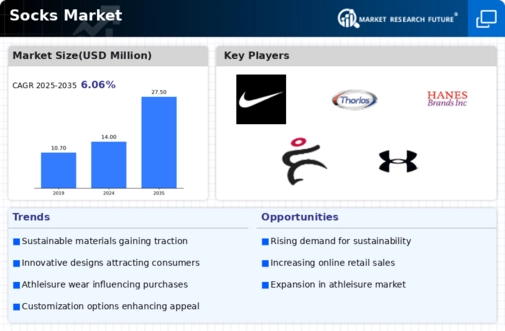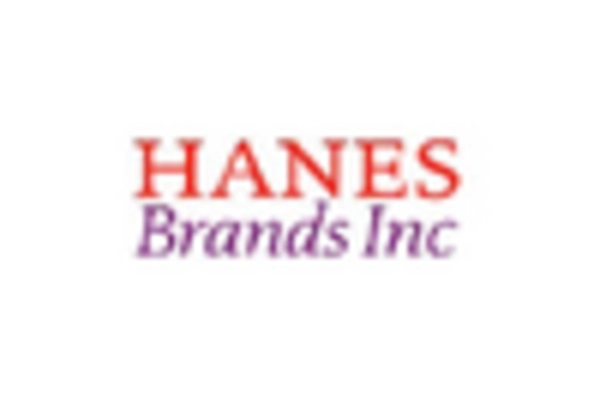Market Analysis
Socks Market (Global, 2023)
Introduction
The sock industry has become a dynamic part of the clothing industry, offering a wide variety of products and designs to meet the preferences and needs of consumers. In response to the growing demand for fashionable and comfortable footwear accessories, the market has experienced a significant transformation. The industry has embraced new materials, designs and manufacturing methods, while pursuing a high degree of social responsibility. The socks are not only for comfort and endurance, but also for style and a sense of self. This has led to the emergence of niche brands and eco-friendly socks, which have further enriched the competition. The rapid development of e-commerce has also changed the way people shop for socks, making it more convenient and diverse. The sock industry has a long history of innovation, and has undergone tremendous changes in the past decade. With the changing preferences and tastes of consumers, the industry is still evolving and developing, and the trends and dynamics need to be understood in order to seize the opportunities in this vibrant industry.
PESTLE Analysis
- Political
- In the year 2023 the sock market was influenced by a number of political factors, including tariffs and import regulations. In the United States, for example, a tariff of 25 percent had been imposed on certain textile imports from China, which included socks. This affected the prices of the American companies that were reliant on Chinese production. They were faced with an increase of roughly 50 cents per pair of socks in their production costs, which they either had to absorb or pass on to the consumers.
- Economic
- In 2023, the American economy is in a state of flux. The average per-capita income is about $4,000, but the rate of savings is falling. Savings have been falling since the year 2000, and so spending on non-essentials, including fashion accessories like socks, has been falling. Inflation has been running at about 3.5 per cent, which has had an adverse effect on the purchasing power of consumers and has resulted in a 10 per cent increase in the retail price of socks compared to the previous year, as brands try to maintain their profit margins.
- Social
- Social trends in 2023 will favour socks made with natural materials and ethically produced. The number of consumers who put the environment first when they buy, which is already about 60 per cent, will increase to 80 per cent. Brands with a sustainable profile have seen their turnover increase by 25 per cent, showing the extent to which consumers’ values are reflected in their buying habits.
- Technological
- The development of knitting machines has given rise to new manufacturing processes, such as 3D knitting. In 2023 about 15% of the sock industry has adopted this technique, which allows for a great variety of designs and greatly reduces waste. The use of 3D knitting machines reduces material waste by up to 20 per cent, which brings down costs and leaves a smaller carbon footprint.
- Legal
- In 2023, regulations on labour and product safety are becoming increasingly stringent. The minimum wage for textile workers has risen to fifteen dollars per hour under the Fair Labor Standards Act. This raises the cost of socks. Testing of materials under the Consumer Product Safety Improvement Act can add up to twenty cents to the cost of each pair of socks. This has an impact on the overall cost of the product.
- Environmental
- In 2023, the sock industry was at the forefront of the battle for the environment. An estimated one million tons of clothing were thrown away each year in the United States alone. Brands had responded by introducing recycling programs and biodegradable materials. Moreover, thirty percent of companies now offered take-back programs for used socks. Waste management aside, this initiative appealed to consumers who were becoming more and more aware of the environment. They were more likely to patronize brands that supported sustainable development.
Porter's Five Forces
- Threat of New Entrants
- The sock market has some moderate barriers to entry, such as brand loyalty and established distribution channels. However, the relatively low investment needed to launch a sock brand makes it easy for new players to enter, especially with the growth of e-commerce. This has created a very competitive market in which new players can quickly gain market share, but to do so they need to be able to differentiate themselves.
- Bargaining Power of Suppliers
- The bargaining power of the suppliers in the hosiery market is low, due to the number of fabric and material suppliers. This is a good thing, because it means that many manufacturers can change suppliers without incurring any significant costs. Also, the wide range of materials used in hosiery production enables the manufacturers to buy from several suppliers at the same time, reducing the power of the suppliers even further.
- Bargaining Power of Buyers
- In the market for socks, the buyer has great power of choice because of the large number of available socks. The buyer can easily change his brand, if he prefers a different quality, if he prefers a different price. This competition forces companies to maintain a price that is competitive and a quality that is good to keep customers.
- Threat of Substitutes
- The threat of substitutes in the sock market is medium. There are other items such as foot covers, tights, and other types of shoes, but socks are an essential item in the wardrobe of most people. Fashions and new products, however, may lead to a change in consumers' tastes, and they may turn to substitutes with similar benefits or even better ones.
- Competitive Rivalry
- Competition is high in the socks market, with numerous established and new brands competing for market share. On the basis of quality, design and marketing strategy, companies compete on various levels. The presence of premium and value brands intensifies competition, which leads to frequent price promotions and product innovations.
SWOT Analysis
Strengths
- Diverse product range catering to various consumer preferences and needs.
- Strong brand loyalty among established players in the market.
- Growing trend of sustainability leading to increased demand for eco-friendly materials.
Weaknesses
- High competition leading to price wars and reduced profit margins.
- Seasonal demand fluctuations affecting sales consistency.
- Limited differentiation in product offerings among many brands.
Opportunities
- Expansion into emerging markets with rising disposable incomes.
- Increased online sales channels and e-commerce growth.
- Potential for innovation in smart socks and wearable technology.
Threats
- Economic downturns affecting consumer spending on non-essential items.
- Supply chain disruptions impacting production and distribution.
- Changing fashion trends leading to rapid shifts in consumer preferences.
Summary
In 2023, the sock market is a mixed bag, with strong and weak points, with loyalty and competition. Opportunities lie in developing countries and in e-commerce, while risks come from economic instability and from problems with supply chains. Companies must focus on innovation and sustainability to ensure they remain competitive and to take advantage of the market trends.









Leave a Comment